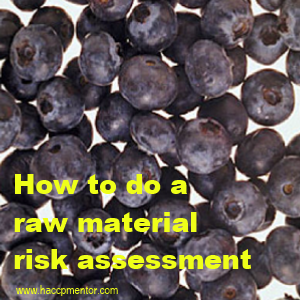Raw material risk assessments can help you to better understand the potential hazards your business will need to deal with. It may also be a requirement of your third party GFSI recognized audit standard. Welcome to session #17 of the HACCP Mentor 101 series. In this session we cover some basics in how to complete a raw material risk assessment.
Understand your raw materials
Before you even attempt to complete a raw material risk assessment you need to firstly understand your raw material. You need to have an idea of the raw materials key attributes, ingredients (if it is a compound ingredient), the country of origin, allergens, packaging type, storage conditions and shelf life. The best place to get this information is from the supplier and the raw material specification. Having this knowledge will help you to work out what raw material potential hazards exist.
What can go wrong?
The identification of potential hazards is the backbone of any risk assessment system. What you are asking is “What could go wrong?”. In the case of raw materials, we want to find out what hazards exist related to any of the following food compliance hazard categories:
- Microbiological
- Chemical
- Physical
- Allergens
- Regulatory
- Quality
- Radiological
- Economically motivated
Check out the raw material information provided by the supplier to help with this process. You can also check out recall databases, USFDA raw material profiles and use your own experience and that of your workers.
Complete the raw material risk assessment
Once you have identified all of the potential hazards that exist for a raw material, you can then complete the raw material risk assessment. The aim of this step is to assess each of the raw material hazards for the likelihood that it will happen and the consequence or impact of the potential hazard should it occur.
Once this step has been completed an overall risk can be allocated to your raw material. If you would like to use my comprehensive raw material risk assessment tool click here to get a copy. Control measures can then be allocated to help mitigate or control this risk.
Document your raw material risk assessment
Like anything related to food safety HACCP compliance, you need to make sure that your raw material risk assessment has been adequately documented. This documentation helps you to:
- Provide proof during the audit process that you have completed this activity
- Show how you worked out or provide justification to the risk ratings that you have allocated to your raw materials.
- Know more about your raw materials and the impact that they can have on your food business operations.
To get a copy of my raw material risk assessment template click here. This template allows you to easily document your own assessment.
Mapping to Key Standards
If you are certified to a GFSI recognized standard there are requirements around completing a raw material risk assessment. Some common references include:
- SQF (Edition 9) – Clause 2.8.2 Allergen Management, Clause 2.4.3 Food Safety Plan
- BRCGS Food Safety (Issue 9) – Clause 2.7.1; Clause 5.3 Management of Allergens (5.3.1)
Register for Training
If you are interested in learning more about how to complete different types of risk assessments in your business, please click here to learn more.

HACCP mentoring is key to food safety and awareness